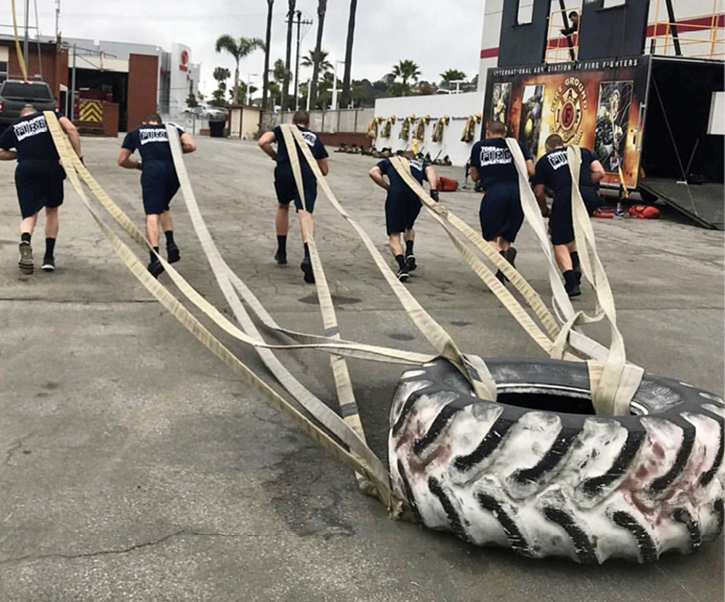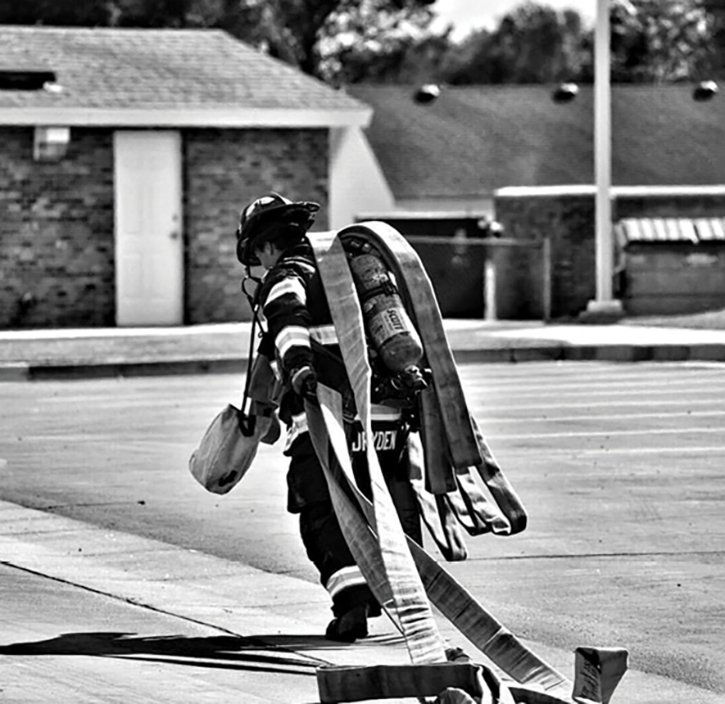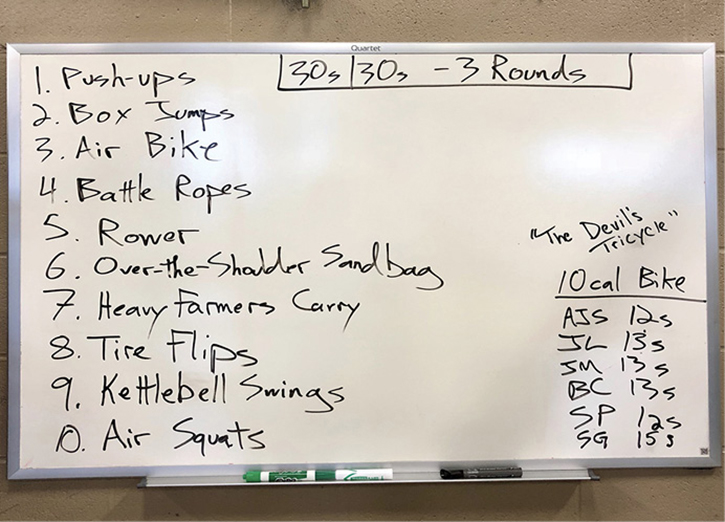
Fitness is essential to the job of firefighting. Period. But whose responsibility is it for you, the firefighter, to be fit for duty? Some may give the excuse that their fire department doesn’t have a fitness program, that they don’t have fitness equipment at their firehouse, or that they don’t know where to begin.
The obligation to be fit for duty lies solely with the firefighter. Whether we have formal fire department support or not, we must take ownership of our personal fitness. But know that there is strength in numbers. Don’t underestimate the power of positive peer pressure. Building a fitness culture at your fire department is achievable, and it can be done at the grassroots level.
RELATED FIREFIGHTER TRAINING
Improving Your Fireground Performance: Firefighter Functional Fitness
No Gym? No Problem? Functional Fitness in the Firehouse
Dan Kerrigan Wants You ‘Functionally Fit’
Why I Teach: Dan Kerrigan and Jim Moss
1. Take Personal Ownership
In our book, Firefighter Functional Fitness, we stress the importance of the three A’s: Accountability, Attitude, and Action. We must personally take full responsibility and have accountability for our fitness. We must also have the right attitude and mindset that our level of fitness is of utmost importance. Finally, we must take action to continually improve ourselves through frequent exercise, sensible nutrition, and healthy habits (e.g., be tobacco free, get sufficient sleep, and stay hydrated, etc.).
2. Hold Others Accountable
If we really care about our fellow firefighters (those we call “our brothers and sisters”), we will expect them to be fit for duty. How do we accomplish this? We ask them to work out with us regularly. Keep your approach open and welcoming, inviting them to your workout with the following queries:
- “Want to work out later?”
- “What time do you want to work out?”
- “What do you want to do for a workout today?”
- “I found a new workout I want to try. Want to do it with me?”
If our crew members agree to join us, let’s be inclusive by adjusting the workout to meet their lower level of fitness. Don’t make the workout so intense that the crew members will never join us again. Sacrificing our normal “high-intensity” routine to include them will pay huge dividends.
Let’s not forget that their level of fitness (or the lack thereof) will ultimately determine the team’s success on the fireground. Our team is only as strong as its weakest link. Our crew won’t be very effective if one member consumes a self-contained breathing apparatus cylinder in five minutes or less.
For officers, we must make daily fitness a part of our crew’s daily regimen. We should be asking ourselves before every shift, “What will I do today to improve the health and fitness of my crew?” Let’s make sure that we are leading by example and that we are communicating our vision to our crews as part of our general expectations.
Most of all, we must lead our crews by our own personal example. Let’s get in the gym and make sure that our crews see us working hard and sweating. Furthermore, we don’t have to be fitness gurus to set up and lead simple workouts at the station—just keep it simple and job related. Use firefighting equipment that helps simultaneously improve firefighter skills and fitness: hoseline deployment and advancement, ladder carries/throws/raises, timed personal protective equipment donning stations, and so forth.
3. Hands-on Training Is a Must
Fire departments with a robust training program more often than not have a strong fitness culture. These are the organizations that get out on the training ground to repeatedly drill on the basics—throwing ladders, stretching lines, forcing doors. Why? Their firefighters know the importance of mastering the fundamentals of the job—tactically, didactically, and physically.
Even if this isn’t the case with our fire department’s training program, we can still do it at the individual and company levels. During downtime at the firehouse, pull equipment off the truck and train with it. Have fun, get a little dirty, and get sweaty!
If you are a company officer who has a few members who are resistant to fitness training, disguise your “workouts” as hands-on training. Kill two birds with the same stone. As long as your crew is physically training and getting their heart rates up, they are simultaneously getting a workout.
4. Bring Personal Fitness Equipment to the Firehouse
Nothing says pride and ownership in our fitness like purchasing or creating our own fitness equipment, then bringing it to the firehouse for everyone to use. It doesn’t have to be expensive items like a treadmill or a complete set of dumbbells. Consider buying lightly used equipment or cost-effective functional fitness items. A kettlebell, a slam ball, resistance bands, a fitness sandbag, a battle rope, and a yoga/gym mat all can be purchased for less than $200. In the same way that multiple members share the cost of a new TV, consider having everyone (or at least those who are passionate about fitness) share the cost of the fitness equipment. It is a small investment that will pay huge dividends.
Let’s consider creating our own fitness equipment by repurposing used tractor tires for dragging or striking with a sledgehammer, using out-of-service hose to practice carrying hose bundles, dragging, battle ropes, wooden pallets for dragging, foam buckets for farmer’s carries, and so forth. To make our training more realistic and functional, we can train in our old, out-of-service turnout gear—as long as it is decontaminated and clean (photos 1-3).

(1) Photo by Dave Sabo.

(2) Photo by John Ford.

(3) Photo by Jim Moss.
5. Hold a Firehouse Fitness Challenge
By our own nature, firefighters are competitive. We love to be the best at everything we do, and we are always trying to outperform those around us. Use that competitive spirit to help everyone get more fit.
Purchase a dry-erase board and hang it in the fitness area or apparatus bay. Write down a simple challenge that will engage other firefighters in the firehouse to participate (photo 4). Write the challenge on the board, and have participants write their names and time/maximum reps they have achieved on the board. Every week, come up with a new challenge, like the following examples:
- Fastest time to run one mile.
- Most push-ups in one minute.
- Holding the longest plank.
- Fastest row machine time for 500, 1,000, 2,000, or 5,000 meters.
- Outline a functional fitness circuit/workout on the board.

(4) Photo by Jim Moss.
The Change Starts with Us
Everyone can be an instrument of change at the grassroots level. We do not have to wait for anyone else to start. Let’s lead by example, invest in ourselves, and then invest in others. We can use positive peer pressure and be inclusive of all fitness levels. Changing the fitness culture at our fire departments will not happen overnight. It will take time, persistence, and passion, but it will be worth it.
Jim Moss and Dan Kerrigan are the authors of Firefighter Functional Fitness: The Essential Guide to Optimal Firefighter Performance and Longevity. They speak internationally at fire departments and conferences, including FDIC International, as part of their mission to “create a healthier fire service, one firefighter at a time.”

